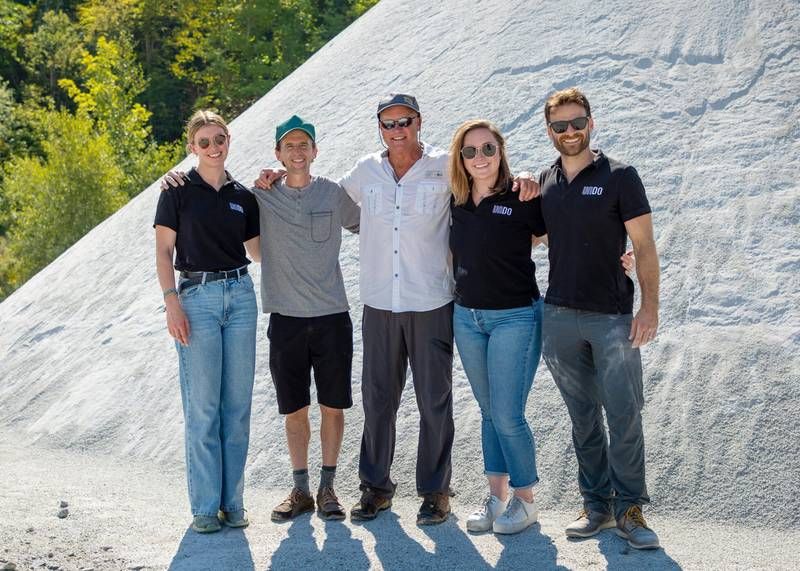Jeff Green | Jan 24, 2024
Globally, the mining industry does not have a stellar reputation for environmental stewardship.
Canadian Wollastonite has a different path.
The mine is located near Seeley's Bay, straddling rural Kingston, the Township of Leeds, the Thousand Islands, and across Highway 15, from the eastern border of South Frontenac.
When it received its final approval in 2010, it was the first new mine that was approved in Southern Ontario in more than 30 years. Fifteen percent of the 220 hectare property where the mine is located, is being mined, and the company is dedicated to low emission mining practices, including a plan to power its entire operation from the electricity grid in the coming years.
The wollastonite is mined at the site for about two months each year, and is crushed on site by the local contractor (Tackaberrys) who conduct the operation with their equipment, leaving only minimal infrastructure on site.
Wollastonite is a calcium silicate. It is bright white and has a ph value of 9.9, the same value as limestone.
The wollastonite that has been mined at the Canadian Wollastonite Mine, has been used as a carbon friendly alternative to other minerals in both steel and cement production.
But starting in 2015, research has been ongoing about another potential use for the mineral, in agriculture.
Crushed wollastonite can be used as an alternative to Lime, raising the pH value of acidic soils and depositing nutrients as it breaks down.
Wollastonite also has other important advantages that will directly benefit farmers, according to the company. It contains plant nutrients such as calcium, magnesium, sulfur, and silicon, which have been proven to be particularly effective in terms of improving stress tolerance, enhancing crop quality, and fortifying plants against pests and diseases.
Research into a process called Enhanced Rock Weathering (ERW) has also shown that when wollastonite breaks down, it bonds with carbon dioxide, which makes its way into the water table, sequestering carbon along the way.
Research partnerships with Guelph, Trent, and Yale Universities have been underway for several years, and a partnership with a new UK based company UNDO Carbon, is bringing the ERW research to the next phase, real world applications in Eastern Ontario farms.
UNDO Carbon, which was established in 2022, is a global pioneer in the field of carbon removal. It is on a mission to permanently remove one billion tons of atmospheric carbon dioxide. They hope to accomplish this through ERW projects both in Canada and various other countries. ERW is designed to accelerate the naturally occurring process of rock weathering by crushing chemically reactive rock into fine silicate powder, thereby exposing more reactive surface area to the elements.
“ERW is UNDO’s permanent, rapid, and scalable carbon dioxide removal technology that has the potential to lock away up to four billion tons of carbon dioxide per year. This equates to 40% of global carbon dioxide removal targets,” according to the UNDO website..
Canadian Wollastonite (CW) and UNDO have partnered in a three-year, carbon removal demonstration project which is the largest initiative of its kind in North America. Their goal will be to show that Enhanced Rock Weathering is a shovel ready, low cost, geoengineering tool that gives participating farmers the opportunity to contribute to the world’s climate change solution.
The successes achieved by the Canadian demonstration project will be used to model, calibrate and scale similar ERW programs around the world.
This is where local farmers come in.
The CW-UNDO operating model makes it possible for the wollastonite itself to be provided free of charge to farmers. The only cost to participating farmers is shipping the product from Canadian Wollastonite’s facility in Seeley’s Bay, and the company is currently offering rebates that will partially offset freight charges.
In exchange, farmers will be asked to keep records, and to allow researchers access to a portion of their fields to conduct more intensive research.
According to Canadian Wollastonite's President, Bob Vasily, researchers will be focusing much of their intensive research on about one hectare out of every thousand hectares where the wollastonite is applied.
“For this project, we are looking at locations within a couple of hours from our mine, which basically means farms in Eastern Ontario,” he said,, adding that he is hoping to attract a variety of farm operations in order to do as broad a research project as possible, including not only the typical cereal grain fields in the region, but other crops as well. That is one of the reasons why the project will be including smaller fields.
Vasily said that although wollastonite seems ideal for this application, there is a limited supply of wollastonite globally. Canadian Wollastonite is the only mine in Canada, and there are two others in New York State.
But the research being done using wollastonite may have the added impact of helping show that the ERW process can be effective using other, more common, minerals, and that could have a global impact down the road,
The arrangement between CW and UNDO Carbon has been structured to make it easy for farmers to take advantage of what the two companies can offer.
Farmers interested in exploring this opportunity are encouraged to contact Canadian Wollastonite to discuss how they can participate. For more information, please visit the company’s website www.canadianwollastonite.com or call Harris Ivens, Project Manager, at (613) 387–2734
More Stories
- Grace Centre Project Nears Completion
- Krista Williams and a Promise Maid
- Opportunities Available in Ontario’s Energy Landscape
- Barb Sproule Retires from North Frontenac role after 44 years
- Central Frontenac Questions Ownership Streetlight
- 1st anniversary celebration at Back to Health in Inverary
- Melvin Jones Award Goes to Lois Emond
- Frontenac Farmer’s Market Set to Open for 2024
- Harrowsmith Public School and the Magic of Theatre
- You’re a Good Man Charlie Brown – a school wide effort at SHS

